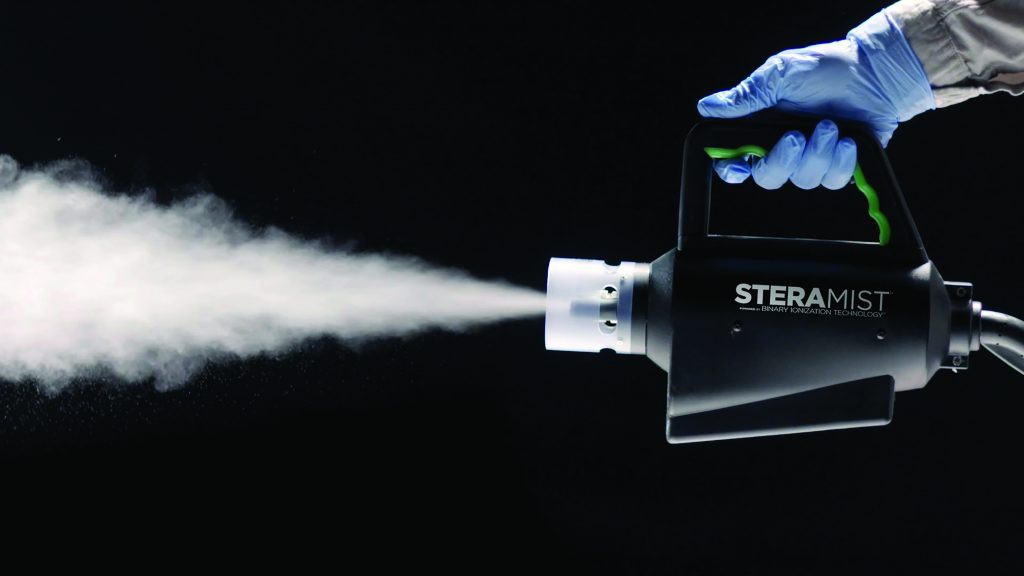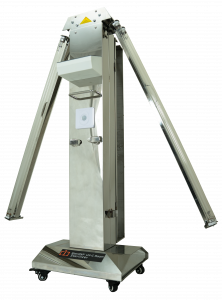Think back to April 2020. People are staying inside their homes. Facemasks are now the go-to personal protection. Teleconferencing has become more popular. And it seems as though the entire world is on pause as the COVID-19 pandemic spreads across the globe.
Fast-forward one year later to today, and many areas of the world still look similar.
One could argue that although the pandemic changed the lives of many, the ability to adapt to unexpected crises shone bright during this time. This was true for companies who provide sanitation and disinfection products to the public.
When companies closed their offices and employees began working from home, there were many professionals who were not able to do so, including police officers and other first responders.
These essential workers not only had the emerging COVID-19 virus to be concerned about, but also the other risks of infections their job potentially puts them in contact with, including MRSA, HIV, staph, herpes, and the flu. It is essential that first responders take preventative measures to keep these diseases from coming in contact with their gear, facilities, vehicles, and bodies.
Fogs and Sprays
Police officers have many threats in their daily work life, including being exposed to dangerous germs and bacteria. However, there are some disinfectants that provide an extra layer of protection for those officers that plain soap and water would not be able to.
For more than 10 years, Clear Gear has helped keep first responders, athletes, schools, and at-home consumers—among many others—safe from dangerous infections and free from odors by killing germs on their gear and protective equipment. Founded from firsthand experience of contracting bacteria by wearing equipment that had not been properly sanitized, Clear Gear advocates for first responders to make infectious control as much a priority as other on-the job protective measures.
Allyson Delius, CEO of Clear Gear, explained that there are three key components to Clear Gear spray disinfectant: non-corrosive, free of chemical smells, and proven to kill COVID-19.1 Headquartered out of Royersford, Pennsylvania, Clear Gear is an EPA-registered disinfectant spray that kills 99.9 percent of germs while also eliminating odors. During the summer of 2020, the EPA confirmed that Clear Gear’s formula kills COVID-19.
The spray contains no bleach, alcohol, chlorine, or peroxide and does not leave noxious fumes behind. The disinfectant can be used on gear, such as helmets, boots, shields, tactical equipment, and facemasks, as well as on larger surfaces like walls and furniture and places like police stations, patrol cars, prisons, and fitness rooms.
Arriving in a refillable bottle, Clear Gear can be sprayed directly on to a surface and be left to dry without leaving a sticky residue. Delius recommends “to spray enough Clear Gear to cover the surface and allow it to remain wet for up to 10 minutes to kill all germs.”2 There is no mixing or wiping necessary.
Another fast-acting disinfection solution that can be quickly applied to police vehicles, holding cells, weapons, gear, and more is TOMI Environmental Solutions’ (TOMI’s) SteraMist.

The Frederick, Maryland-based company originally created SteraMist disinfectant with the Defense Advanced Research Projects Agency in direct response to a U.S. weaponized anthrax attack. According to Dr. Halden Shane, CEO and chief scientific officer, “Though originally created as a response to bio-terrorism, the applications of the innovative technology grew far beyond the initial scope of expectation and was found to be extremely effective in disinfecting and decontaminating at high levels within limitless use sites.”3
The technology was commercialized for public use in 2009 and has been thoroughly tested and validated through third-party labs and government agencies such as the EPA, Food and Drug Administration, Center for Biological Defense, and Sandia National Labs.
SteraMist turns to the power of ionized hydrogen peroxide (iHP), a low-percentage hydrogen peroxide disinfection method, and TOMI’s patented binary ionization technology (BIT). The iHP technology was created to avoid causing damage to materials or sensitive equipment.
During TOMI’s iHP process, all bacteria spores, fungi, and fungal spores are killed, and viral particles are inactivated, including the COVID-19 virus. Previously used disinfectants relied on high levels of hydrogen peroxide to break down the viruses and bacteria using high parts per million of nebulized peroxide over hours, whereas SteraMist uses iHP technology to quickly destroy viruses and bacteria in seconds and minutes, leaving no residue with the only byproducts being oxygen and humidity.
TOMI—alongside third-party labs and government agencies—actively continues to validate the SteraMist disinfection system to ensure its efficacy.
SpectraShield Technologies LLC (SST) is a Scottsdale, Arizona–based company that is a licensee of the third-party lab, Sandia National Labs. With an offering of three different products, SST manufactures certified-green, biodegradable disinfectants that can manage everything from daily disinfection to hazmat decontamination.
DF-200 provides dirty bomb protection with proven efficacy against sarin nerve gas, anthrax, and other high-level pathogens. DF-500 offers high-level disinfection in a certified green product that is biodegradable. The third offering, SpectraKill RTU, is a proprietary, ready-to-use product that is great for daily disinfection. SpectraKill disinfectants do not contain any bleach, phenols, or volatile organic compounds.
“Most disinfectants kill microorganisms through poisoning the pathogen to death. The same toxicity that poisons microorganisms is the same reasons most disinfectants are poisonous to humans and the environment,” said President and CEO Thad Weist. “SpectraKill is different.”4 Weist explains that SpectraKill cleaves the spore wall through oxidation and strips the organism of electrons, which occurs because of an absence of electrons in SpectraKill.
Alternative Methods
Although spray and fog disinfectants are commonly seen in everyday use, there are also alternative methods that companies provide in order to sterilize surfaces.

Headquartered in San Diego, California, Genlantis/FirstResponder Technologies provides innovative products that keep police vehicles and facilities sterilized. The patented technology behind the FirstResponder Ozone and SteriZAP UV-C light sterilization products eliminates up to 99.99 percent of common pathogens in less than an hour. Both effectively decontaminate EMS vehicles, fitness areas, restrooms, and contained law enforcement rooms without harsh chemicals or residue.
The FirstResponder Ozone sterilizer is proven to be effective at eliminating both surface and airborne pathogens. This portable sterilizing unit generates high levels of triatomic oxygen (ozone) to clean first responder vehicles.
The SteriZAP UV-C device produces ultraviolet light with wavelengths shorter than visible light. Anthony Sorge, CEO of Genlantis, said, “Germicidal UV-C kills or inactivates microorganisms by destroying their nucleic acids and disrupting their DNA, leaving them unable to perform vital cellular functions.”5 The SteriZAP UV-C sterilizer is intended for use in the disinfection of surfaces in laboratories, hospital rooms, food-processing areas, and any places where sterilization is desired.
As police officers continue to work on the front lines during the global pandemic and beyond, it is important that they have the proper personal protective equipment; however, it is also important that they have the proper disinfectant and sanitization tools to keep that gear safe from transferring harmful bacteria contracted on the job.
From sprays and fogs to UVC technology, there are many options in preventing the spread of COVID-19, as well as other viruses or bloodborne illnesses officers may encounter. d
Notes:
1Allyson Delius (chief executive officer, Clear Gear), email interview, March 8, 2021.
2Allyson Delius (chief executive officer, Clear Gear), telephone interview, March 10, 2021.
3Halden Shane, PhD (chief executive officer and chief scientific officer, TOMI Environmental Solutions), email interview, March 5, 2021.
4Thad Weist (president and chief executive officer, SpectraShield Technologies LLC), email interview, March 8, 2021.
5Anthony Sorge (chief executive officer, Genlantis/FirstResponder Technologies), email interview, February 28, 2021.
SOURCE LISTPlease click the links below to go to the companies’ websites or visit Police Chief Online Buyers’ Guide to request information from companies. |
|
|---|---|
|
|
|


